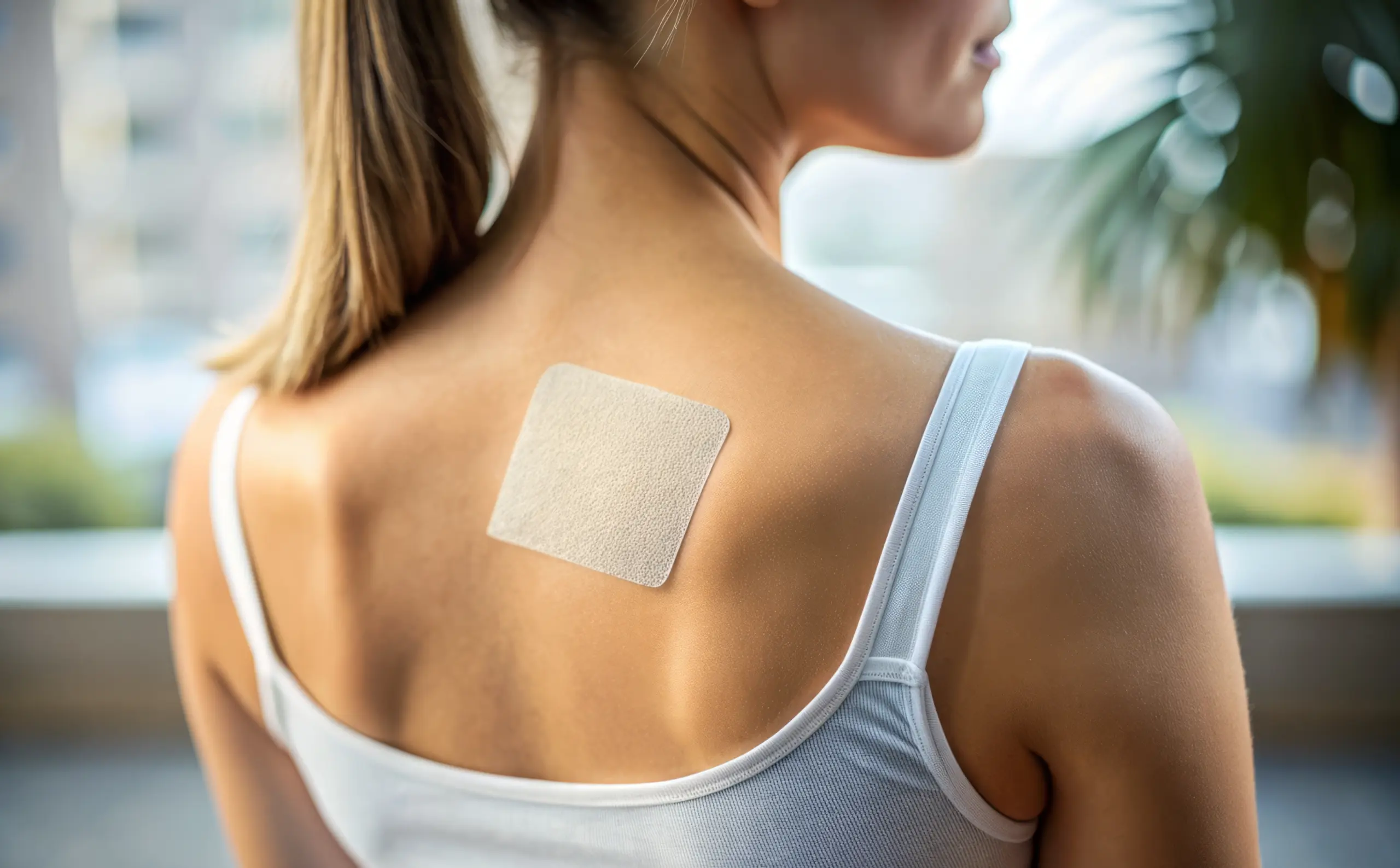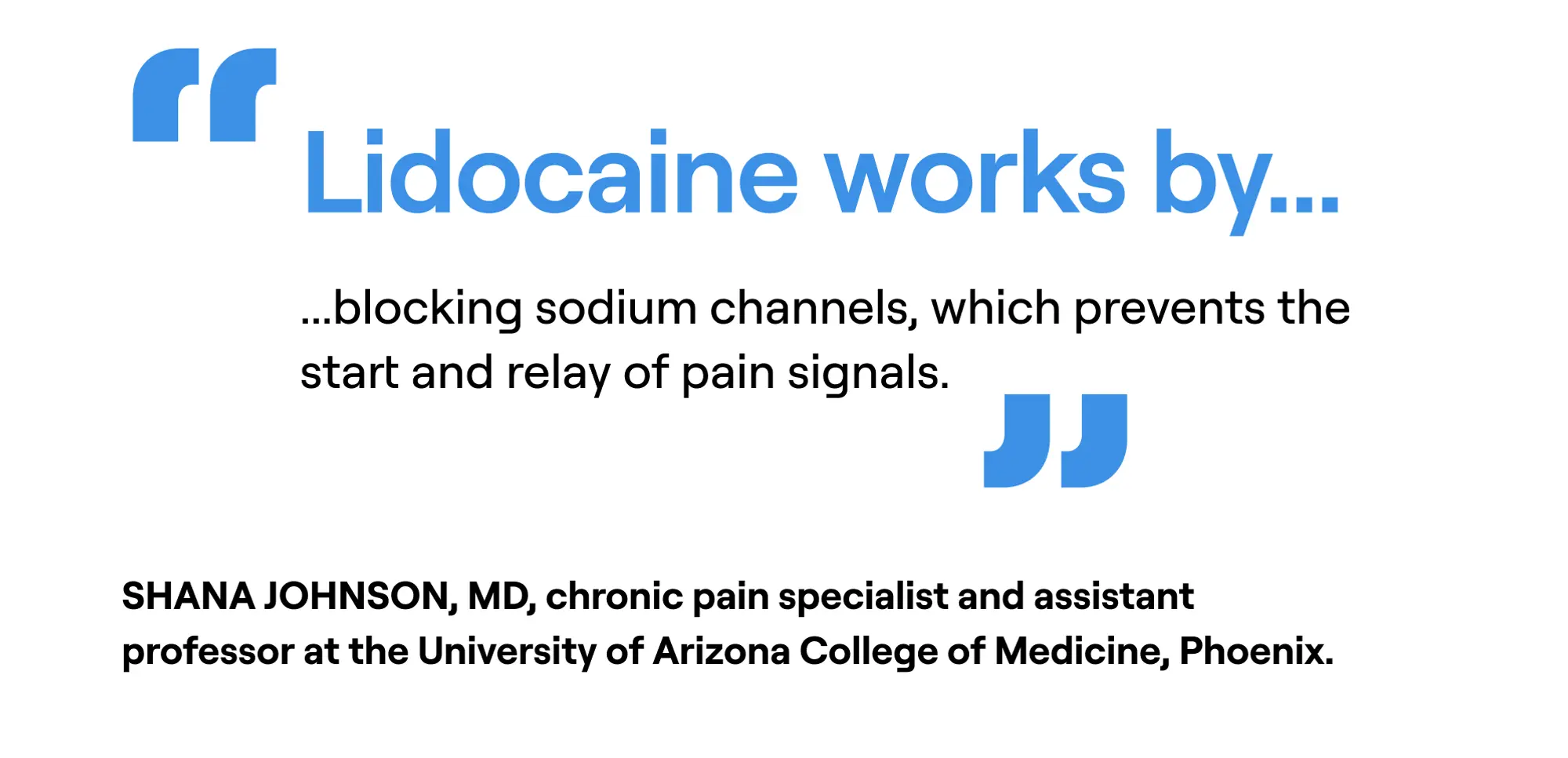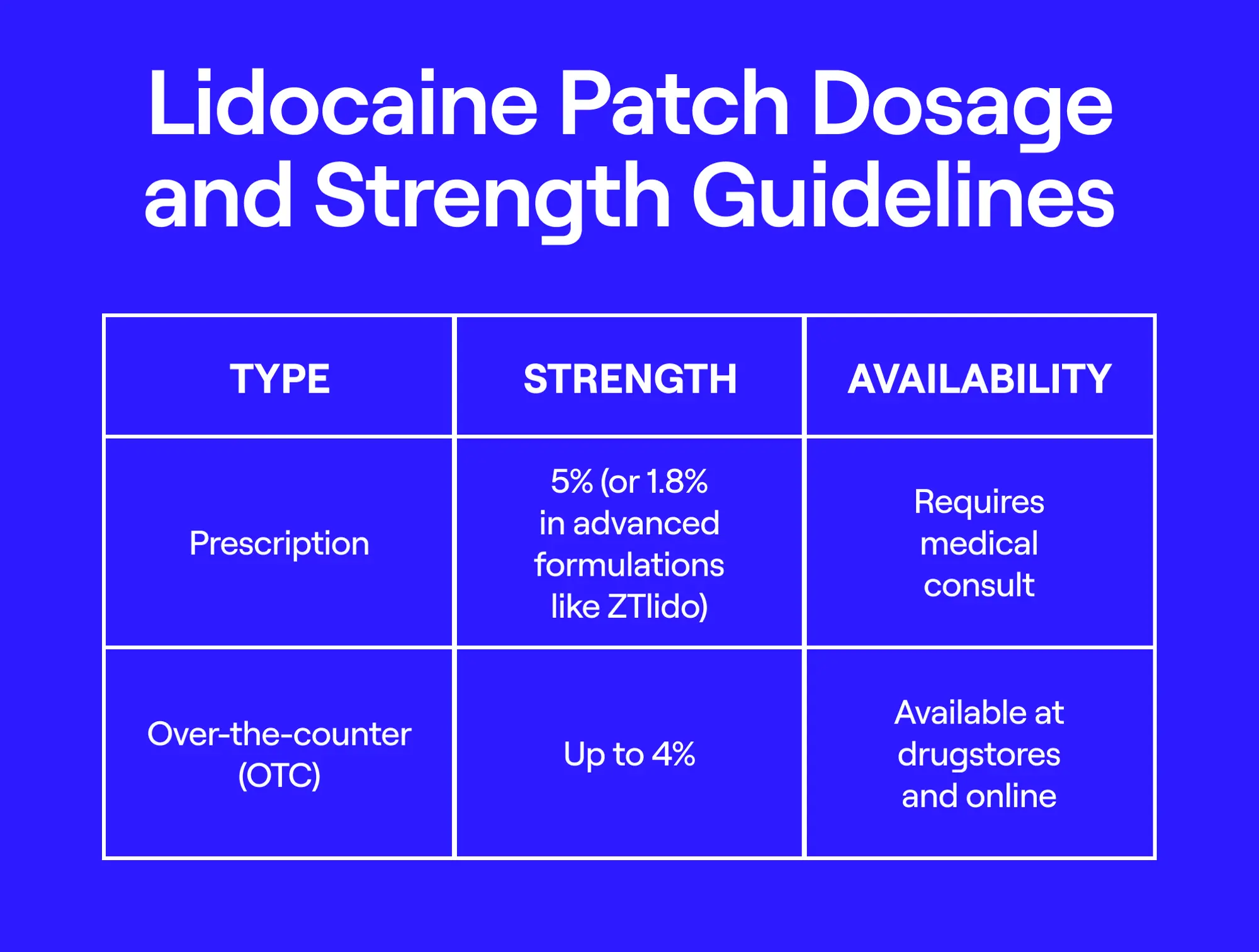
Jump to
Book a visit
$25 typical copay
$100 without insurance
Get expert care for your pain today.
If you're dealing with persistent back pain, arthritis, or nerve discomfort, a lidocaine patch may offer the targeted relief you've been searching for. These discreet, easy-to-use patches deliver medication right where you need it, without the systemic effects of oral drugs. And thanks to telehealth, you can now safely get prescription lidocaine patches online, without setting foot in a doctor’s office.
Lidocaine patches numb the nerves at the surface of your skin, blocking pain signals without affecting your whole body. They’re a go-to for localized pain like nerve issues from shingles or neuropathy, as well as arthritis, backaches, sprains, or post-surgery soreness. Over-the-counter patches pack up to 4% lidocaine for mild aches. But if you need stronger relief, prescription patches deliver up to 5%. Just remember to wear them no longer than 12 hours, followed by a 12-hour pause to give your skin a break before reapplying.
In this guide, we’ll break down how lidocaine patches work, the differences between over-the-counter and prescription strengths, and how to use them safely and effectively. We’ll also walk you through how to get a prescription for a lidocaine patch online.
What Is a Lidocaine Patch?
A lidocaine patch is a topical anesthetic that delivers pain relief through the skin. “Lidocaine works by blocking sodium channels, which prevents the start and relay of pain signals,” says Shana Johnson, MD, a chronic pain specialist and assistant professor at the University of Arizona College of Medicine, Phoenix.

Quote from Shana Johnson, MD on how lidocaine works
Sodium channels are small gateways in nerve cells that help transmit electrical signals, says Thomas Pontinen, MD, a double-board-certified pain management physician and co-founder of Midwest Anesthesia and Pain Specialists in Chicago. When they’re blocked, pain messages can’t reach your brain.
Unlike oral medications that travel through your bloodstream and affect your whole body, lidocaine patches work on a local level, adds Johnson. You apply them directly to the painful area, where they numb the surrounding nerves.
Importantly, though, “these patches do nothing to help the underlying cause of the pain,” says Pontinen. Instead, they provide temporary relief from the discomfort.
Common Uses for Lidocaine Patches
Lidocaine patches are most effective for localized, surface-level pain, not widespread or deep tissue pain (such as sciatica, fibromyalgia, or pain from internal organs), says Pontinen.
That said, they can be a highly effective tool in managing certain types of discomfort. According to Johnson and Pontinen, common conditions they help manage include:
- Postherpetic neuralgia (nerve pain from shingles): Prescription lidocaine patches are FDA-approved to relieve nerve pain from shingles. They work by dulling pain signals in the skin affected by shingles.
- Neuropathy: Prescription patches are also used off-label to ease the nerve-related burning, tingling, or shooting pain that often occurs in the hands, feet, or limbs from diabetic or peripheral neuropathy.
- Back pain: Similarly, doctors often prescribe a lidocaine patch for back pain or muscle tension to numb the affected area.
- Arthritis pain (like knee or shoulder osteoarthritis): Patches are also prescribed off-label to reduce inflammation-related joint pain by dulling the nerve signals on the skin around the joint.
- Post-surgical pain: Lidocaine patches may ease pain around healing incisions or surgical areas by numbing the site.
- Strains or injuries: For muscle sprains, tendonitis, or overuse injuries, patches can help reduce localized soreness and discomfort.
These patches are especially helpful when oral medications are not well tolerated or when you want a more localized option that doesn’t affect the rest of your body, adds Pontinen.
Lidocaine Patch Dosage and Strength Guidelines
Both prescription and over-the-counter (OTC) lidocaine patches are available. Here’s the breakdown:
- Prescription patches: Prescription patches are FDA-approved to treat nerve-related pain. Some options, like Lidoderm, contain a higher concentration of lidocaine—typically 5%—which allows them to deliver stronger, longer-lasting relief. However, “a newer prescription lidocaine patch, called ZTlido, offers more efficient delivery of lidocaine: A lower amount of drug (1.8%) to achieve the same therapeutic effect,” says Johnson.
- OTC patches: These patches are available at most pharmacies, and typically contain 4% or less of the active ingredient. While OTC versions can still be helpful for mild or moderate pain, such as muscle soreness or occasional back pain, they may not provide the same level or duration of relief as their prescription counterparts.
Dr. Pontinen recommends following your doctor’s guidance and product instructions to make sure you’re using your specific lidocaine patch safely and effectively.

Lidocaine patch dosage and strength
But “generally speaking, lidocaine patches can be used for up to 12 hours on, followed by 12 hours off. Don’t exceed 12 hours of patch use within any given 24-hour period,” says Pontinen. “If you’re applying patches at the same time, it’s generally recommended to apply no more than three at once.”
Overusing patches or leaving them on longer than recommended can lead your body to absorb higher doses of lidocaine. “In higher doses, lidocaine has effects on the heart, so you want to keep dosing within the recommended parameters,” explains Johnson.
Proper Application and Usage
Proper application matters when it comes to getting the best results from your lidocaine patch. Follow these steps to ensure you’re using it safely and maximizing its pain-relieving effects:
- Clean the skin where you plan to apply the patch. Make sure your skin is completely dry, as moisture can interfere with how well the patch sticks and how the medication is absorbed, says Pontinen. Avoid using the patch on broken, inflamed, or freshly shaved skin, which can increase irritation or risk of side effects, adds Johnson.
- Peel off the backing and press the patch firmly in place. Hold it down for a few seconds to ensure it sticks well, says Pontinen. Just avoid applying heat—like heating pads, hot showers, or electric blankets—while wearing the patch, says Johnson. Heat can cause your body to absorb too much medication too fast.
- Wear the patch for up to 12 hours. If it’s your first time using a lidocaine patch, just make sure to monitor your skin for signs of an allergic reaction (like a rash, itching, or redness), says Johnson.
- Remove the patch. After 12 hours, remove the patch and leave the area patch-free for the following 12 hours to avoid absorbing excessive doses of lidocaine.
To protect your skin, rotate where you apply the patch each time. “Rotate where you’re applying the patches so that your skin gets a break and is less likely to get irritated over repeat use,” says Pontinen.
How Long Do Lidocaine Patches Last?
Prescription-strength lidocaine patches like Lidoderm or ZTlido are usually meant to be worn for up to 12 hours, followed by 12 hours off to allow your skin to recover and prevent excessive absorption, according to the prescribing information.
For some people, though, the numbing effects don’t stop the moment the patch comes off. Pain relief can continue for several hours afterward, depending on how your body absorbs and responds to the medication, says Pontinen.
OTC lidocaine patches usually provide shorter-lasting relief, often around eight hours. It varies from brand to brand, so make sure you follow the instructions listed on your specific product.
As with any medication, how long relief lasts can vary based on pain level and overall health. Some people experience consistent, lasting relief, while others may find they need to pair patches with other pain management strategies (like physical therapy) for full support.
Lidocaine Patch Side Effects and Safety
"Topical lidocaine is safe when used as directed by the prescription or product labeling," says Johnson. The most common side effects of lidocaine patches are pretty mild, says Pontinen. They can include:
- Mild skin irritation
- Redness or itching at the site
- Numbness beyond the application area (if overused)
However, "overusing patches or leaving them on too long can lead to higher doses being absorbed systemically," says Johnson. While rare, severe side effects can occur in cases of allergy or overdose, and may include:
- Allergic reactions (rash, swelling, difficulty breathing)
- Lightheadedness, dizziness, and confusion
- Blurred vision
- Ringing in the ears
- Vomiting
- Irregular heartbeat
- Seizures
- Loss of consciousness
“If someone experiences these symptoms, call the poison control helpline and seek immediate medical attention,” says Pontinen.
Can You Use Lidocaine Patches While Pregnant?
Topical lidocaine is classified as a Category B drug by the FDA, which means animal studies haven’t shown harm to the fetus. One older study suggests that 2.5% topical lidocaine is considered safe for use during pregnancy as long as it’s not used around the eyes. However, larger and more recent studies in pregnant humans are lacking.
In other words, there’s no evidence that lidocaine is harmful during pregnancy. But because research is limited, it should only be used if it’s clearly needed—and only under medical supervision.
The takeaway: If you’re pregnant, it’s best to talk to your OB-GYN before using any lidocaine patch. The safety can vary depending on how much is used, how often, where it’s applied, and whether your skin is broken or irritated. Your doctor can determine if it’s right for you based on your symptoms, trimester, and overall health.
Prescription vs. OTC Lidocaine Patches: What’s the Difference?
Not all lidocaine patches are created equal. Depending on the intensity and cause of your pain, you might need a stronger option than what’s available over the counter. In general, if you’ve tried OTC versions without adequate relief, it may be time to talk to a provider about prescription lidocaine patches.
Here’s how prescription and OTC lidocaine patches compare:
Where To Safely Get Lidocaine Patches Online
Looking for the easiest way to get prescription lidocaine patches online? General Medicine’s streamlined process not only saves time; it gives you clinically guided, medical-grade pain relief without the hassle of in-person visits or confusing pharmacy pickups.
Here’s how it works:
- Visit General Medicine’s Lidoderm page to book a same- or next-day video or chat consultation.
- A licensed provider will review your symptoms, medical history, and current treatment needs.
- If it’s a good fit, they’ll prescribe a lidocaine patch as part of a care plan tailored to your pain needs.
Choose your preferred pharmacy, and your care team will handle the rest. They’ll submit the order and notify you when it’s ready for pickup.
The Takeaway
- Lidocaine patches work by numbing local nerves, blocking pain signals at the skin level without affecting your whole body.
- They’re especially helpful for localized pain, including nerve-related pain (like postherpetic neuralgia or neuropathy) and musculoskeletal issues such as arthritis, back pain, sprains, or post-surgical discomfort.
- Over-the-counter patches contain up to 4% lidocaine and are best for mild or temporary pain, while prescription-strength patches contain 5% lidocaine and are more effective for moderate to severe or chronic pain.
- To use them safely, don’t wear a patch longer than 12 hours at a time, and always wait at least 12 hours before reapplying. Avoid heat (like heating pads or hot showers) while wearing the patch, as it can increase the amount of medication absorbed.
- If OTC patches haven’t worked for you, you can request a prescription lidocaine patch online through General Medicine’s telehealth platform—no in-person visit required.
General Medicine follows a strict editorial process, including using real experts to write our articles, vetted primary sources, fact-checking, a secondary medical review, and updates as necessary. This article was medically reviewed and fact checked by Adam Carewe, MD, and Marjory Bravard, MD.
FAQ
What does a lidocaine patch do?
A lidocaine patch delivers a local anesthetic through the skin to numb the nerves in the area where it’s applied. It blocks sodium channels in your nerve endings, which stops pain signals from traveling to the brain. This makes it especially helpful for targeted pain relief without affecting the rest of your body.
Is lidocaine patch 5% a narcotic?
No. Lidocaine is not a narcotic or opioid. It’s a local anesthetic, meaning it numbs a specific area without the risk of dependence or euphoria that narcotics carry. This makes it a popular alternative for people seeking non-opioid pain relief options.
What is the strongest prescription lidocaine patch?
There are two commonly prescribed options: Lidoderm (5%) and ZTlido (1.8%). While Lidoderm contains more lidocaine by percentage, ZTlido is designed to deliver the same therapeutic dose with less medication thanks to improved skin absorption. So in terms of effectiveness, both are considered equally strong—ZTlido just gets there more efficiently.
Does lidocaine heal or just numb?
Lidocaine just numbs pain—it doesn’t heal the underlying condition, reduce inflammation, repair tissue, or treat the root cause. That’s why it’s best used as part of a broader treatment plan.
How long can you safely leave on a lidocaine patch?
The general guideline is to wear most prescription-strength patches for up to 12 hours, followed by 12 hours off. This break allows your skin to recover and prevents too much lidocaine from building up in your system. Always follow the instructions on the label or those provided by your healthcare provider.
What is lidocaine patch used for?
A lidocaine patch is used to relieve localized pain by numbing the area where it's applied. It’s commonly used for nerve-related pain (like postherpetic neuralgia from shingles or diabetic neuropathy) and musculoskeletal pain such as arthritis, lower back pain, sprains, strains, or post-surgical discomfort.
Is lidocaine a strong painkiller?
Lidocaine is highly effective for treating surface-level, localized pain, such as nerve pain, joint pain, or muscle aches, in a specific area. However, it’s not effective for deep or widespread pain since it doesn’t penetrate deeply or travel through the bloodstream. Think of it as a focused pain reliever, not a full-body solution.
Our editorial standards
At General Medicine, we cut through the clutter to make health care clearer, faster, and easier to navigate. Every article is grounded in evidence-based research and peer-reviewed journals, reviewed by medical professionals, and written in accessible language that helps you make health decisions with confidence. We’re committed to ensuring the quality and trustworthiness of our content and editorial process by providing information that is up-to-date, accurate, and actually useful. For more details on our editorial process, see here.



